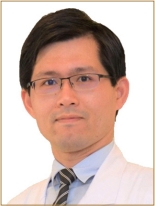

Spinal tuberculosis (TB) can lead to spinal deformities and neurological deficits. The diagnosis of spinal TB involves a combination of various modalities, such as clinical evaluations, imaging features, acid-fast stain smear, mycobacterial culture, and histologic and/or cytologic assessments [
1]. The rationale for surgical intervention lies in preserving neurological function and preventing spinal kyphotic deformity [
2]. The choice of surgical strategies, including decompression and instrumentation for stabilization and correction of deformities, is determined on a case-by-case basis [
1]. The optimal timing for surgical intervention in patients with spinal TB is still a subject of debate. Performing surgery during the active stage is generally considered more feasible for spinal correction than in the healed stage [
1]. Spinal TB in the healed stage may result in angular deformities, with or without associated neurological deficits [
3]. Combined approaches may involve anterior corpectomy, posterior shortening and instrumentation, and anterior and posterior grafting [
4,
5]. The selection of the technique depends on the severity of the angular deformity.
This article [
6] presents a retrospective comparative study conducted over 3 years, focusing on the treatment of single-level lumbar tuberculosis using a simultaneous single-position oblique lateral interbody fusion (SP-OLIF) combined with unilateral percutaneous pedicle screw fixation. This approach provides a minimally invasive alternative to the traditional posterior-only approach. The study aimed to evaluate the SP-OLIF approach in comparison to the traditional posterior-only method in terms of clinical and radiographic outcomes. The study included 136 patients, with 60 in the SP-OLIF group and 76 in the posterior-only group. Results showed that the SP-OLIF group exhibited significantly lower mean operative time, blood loss, and hospital stay compared to the posterior-only group. The SP-OLIF group also demonstrated a lower complication rate. Clinical efficacy evaluation revealed lower visual analogue scale scores for back pain and decreased Oswestry Disability Index in the SP-OLIF group. Laboratory indicators, including C-reactive protein and erythrocyte sedimentation rate, were significantly lower in the SP-OLIF group. Radiographically, the accuracy of screw placement in the SP-OLIF group was comparable to the posterior-only group, with no significant differences between the 2 groups. Fusion assessment according to BridwellŌĆÖs criteria showed similar results for both groups.
In a separate study [
7] that included 20 cohort studies examining surgical techniques for TB, the anterior approach demonstrated advantages over the posterior approach. The anterior approach was linked to a quicker perioperative duration, reduced blood loss, shorter hospitalization, improved angle correction, and higher correction rates. Both the anterior and posterior approaches were equally effective in terms of neurological function recovery, although the posterior approach was associated with a higher incidence of complications. The review also addressed complications related to surgical approaches, with 9 out of 20 studies reporting complications. Overall, the anterior approach exhibited fewer complications. The conclusions and findings of this study aligned with those reported in the published paper.
Spinal infections may be preceded by infections in various body systems, and certain factors such as diabetes, rheumatoid arthritis, chronic steroid use, and intravenous drug abuse can increase susceptibility [
8,
9]. Antituberculous treatment remains the cornerstone for spinal TB, with surgery required in selected cases [
10]. The SP-OLIF approach for single-level lumbar tuberculosis emerges as an efficient and minimally invasive protocol, offering advantages of reduced blood loss, operative time, and hospital stay [
6]. With early diagnosis and treatment, the prognosis for TB is generally favorable.

























